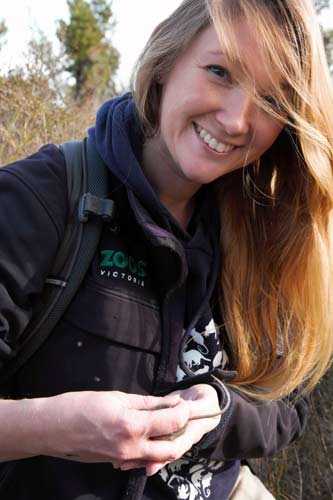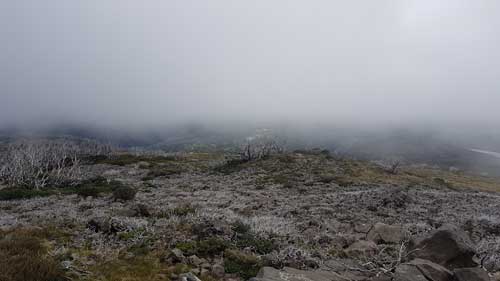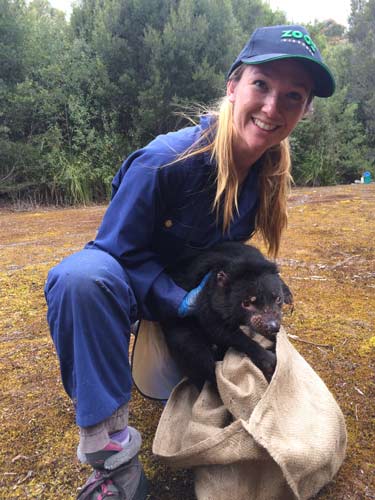Marissa Parrott: Fighting Extinction
After completing a PhD at the University of Melbourne, Marissa Parrott landed her dream job with Zoos Victoria. She now dedicates every day to the conservation of wildlife and, despite increasing challenges, she still holds out hope for the future.
I have my dream job because every day I get to help fight extinction
 I have always loved animals and always wanted to work in breeding and reintroduction programs in zoos. As I grew up, I realised that my passion was for conservation and making a difference for all wildlife, with a special soft spot for Australia’s unique animals like marsupials, rodents and frogs.
I have always loved animals and always wanted to work in breeding and reintroduction programs in zoos. As I grew up, I realised that my passion was for conservation and making a difference for all wildlife, with a special soft spot for Australia’s unique animals like marsupials, rodents and frogs.
I have my dream job at Zoos Victoria, because every day I get to help fight extinction and make a difference.
I am very lucky that there is no ‘typical day’ at the zoo! I work across a variety of zoo, office and wildlife areas with amazing animals and people. On any given day, I could be in a government meeting discussing bushfires and conservation strategies, working with our expert keeping and vet teams at one of our three properties, rising before dawn to survey beautiful wild species like Eastern Barred Bandicoots, Tassie Devils or Smoky Mice, or in my office analyzing our research findings or working with my students.
In 2007, I joined Zoos Victoria to work on the breeding program for the critically endangered Mountain Pygmy-possum. I was then given my dream rolein Zoos Victoria’s Department of Wildlife Conservation and Science as their Reproductive Biologist in 2009.
I work across Healesville Sanctuary, Werribee Open Range Zoo, Melbourne Zoo and a variety of field sites from grasslands and forests to waterways and the alps, to improve sustainable zoo populations, conduct reproductive and reintroduction research, and focus on long-term conservation outcomes, particularly for threatened species.
I continue to work closely with the University of Melbourne, as an Honorary Research Associate in the School of BioSciences, and through supervising postgraduate students on many exciting wildlife projects.
This summer, we faced some of the worst bushfires in Australia’s history
Many areas that were burnt are home to threatened species, and thus these fires have pushed many species even closer to the brink of extinction. Fires, drought and associated problems are getting worse and they are placing a huge strain on our already imperiled wildlife.
We are still discovering how badly these animals were affected – it will be a long road to ascertain the damage, protect the animals and work together to recover them for the future.
It is estimated that more than 1 billion animals are dead, but in fact that number will be much higher, because it doesn’t include bats, fish or invertebrates where we just don’t have enough information on know how many were killed.
The recent bushfires have left us all exhausted, but there is so much left to do
 Zoos Victoria were on the front line treating burnt koalas, evacuating endangered birds and wallabies as fires approached, and working around the clock to help develop, trial and deliver food to starving animals. It felt like the apocalypse for many of us.
Zoos Victoria were on the front line treating burnt koalas, evacuating endangered birds and wallabies as fires approached, and working around the clock to help develop, trial and deliver food to starving animals. It felt like the apocalypse for many of us.
Eleven years ago, I helped evacuate Healesville Sanctuary during the Black Saturday bushfires. Thankfully, we were spared, but 173 people were killed, over 3500 homes lost, and countless animals were burnt in the firestorm.
Last year, our partners at the Carnivore Conservancy and I had to evacuate our field station in Tasmania as ash fell, helicopters zoomed by and flames drew closer. Luckily our devils were safeand so was the Conservancy’s house in the end, but others were not so lucky.
This summer, I drove towards the alps to work with critically endangered Mountain Pygmy-possums through smoke and orange haze. Once bustling towns were silent, and the only other cars on the road other than ours were defence force vehicles there to help evacuate people and protect them from fires. It is all very surreal when I think back on it.
The fires are getting worse, the droughts are getting more extreme, and it is terrifying.
In the past five years, more and more species have been added to the threatened species list, and many already on the list have moved closer to being extinct . This was likely vastly increased following the 2019-20 fires.
There is so much work happening to protect endangered animals and care for those injured during fires, but it is a marathon, not a sprint, and we need to support them long-term to get them safe and back in the wild.
There are signs of hope
 Sometimes the problems faced by our wildlife feel very overwhelming.
Sometimes the problems faced by our wildlife feel very overwhelming.
The extinction of the Bramble Cay Melomys in 2016 was a true tragedy – the first recorded mammal extinction due to human-induced climate change. It never should have happened. It could have been prevented. It wasn’t, and now a unique and beautiful Australian rodent is gone forever.
However, there are wins and signs of hope.
At Zoos Victoria, we have a commitment that no Victorian Terrestrial Vertebrate species will go extinct on our watch. While it can be extremely hard and heartbreaking work , i t is something I am passionate about.
In the past 5 years, we have worked to release mainland Eastern Barred Bandicoots, a species listed as extinct in the wild, to live as wild on three islands. Their numbers are increasing and they, and their island homes, are looking great!
| Read more about how our researchers are helping populations of pygmy possums and bandicoots through genetic rescue. |
|---|
Each time we release animals back to live in the wild, we celebrate.
I am an eternal optimist that we can make a difference and we can save species – there is always hope.
We are now focused on protecting animals after the fires, and preparing for the future using funds raised through Zoos Victoria’s Bushfire Emergency Fire Fund. This includes development of emergency housing and husbandry, veterinary facilities and care, feeding regimes and new species-specific supplementary foods, and specialists to help species at risk.
Join our citizen science project, Moth Tracker
Mountain Pygmy-possum rely on Bogong Moths as a key food source. Each spring, swarms of Bogong Moths migrate from their breeding grounds to the alpine regions where Mountain Pygmy-possums live. In 2017 and 2018, however, the number of Bogong Moths arriving in these areas crashed, from billions to being nearly undetectable.
So, in 2019, Zoos Victoria launched the new citizen science platform Moth Tracker on the SWIFFT website. Getting involved is fun - you just need to take a photo of a moth that you think may be a Bogong Moth (check the website for images and tips) and upload your photo, the number of moths, date, time and location.
This information is then provided to researchers and the Mountain Pygmy-possum Recovery Team so that, together, we can learn more about the species and how to help them.
You can also help Bogong Moths and Mountain Pygmy-possums by switching off unnecessary outdoor lighting at night that can draw moths away from their migration routes.
| Read more about Bogong Moth migration and the Lights Out Campaign. |
|---|
Connect with Dr Marissa Parrott and join the Science Alumni Group on LinkedIn.